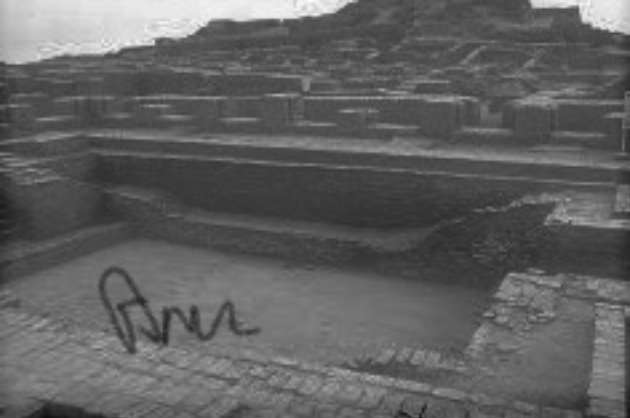Anupama Nair
There are many ancient civilizations and architectural wonders which feels us with awe. Let me take you to a journey thousand of years ago. So put on your seatbelts and enjoy the travel through time starting with the Indus Valley Civilization and the Pyramids of Egypt till the Tower of Alexandria.
Indus Valley Civilization
In 1856, British colonial officials in India were busy monitoring the construction of a railway connecting the cities of Lahore and Karachi in modern-day Pakistan along the Indus River valley. As they continued to work, some of the laborers discovered many fire-baked bricks lodged in a dry terrain. There were hundreds of thousands of fairly uniform bricks, which seemed to be quite ancient. However, the workers used some of them to construct the road bed, unaware that they were using ancient artifacts. They soon found among the bricks stone artifacts made of soapstone, featuring intricate artistic markings.
It was only in the 1920s, these railway workers saw the remnants of the Indus Valley Civilization, also known as the Harappan Civilization, after Harappa, the first of its sites to be excavated, in what was then the Punjab province of British India and is now in Pakistan. Initially, many archaeologists thought they had found ruins of the ancient Maurya Empire, a large empire which dominated ancient India between 322 BC and 185 BC.
Before the excavation of these Harappan cities, scholars thought that Indian civilization had begun in the Ganges valley as Aryan immigrants from Persia and central Asia populated the region around 1250 BC. The discovery of ancient Harappan cities disproved the theory and moved the timeline back another to 1500 years. Scholars are still trying to decipher information about this mysterious civilization, but they have learned a great deal about it since its re-discovery. Its origins seem to lie in a settlement named Mehrgarh in the foothills of a mountain pass in modern-day Balochistan in western Pakistan. There is evidence of settlement in this area as early as 7000 BC.
Harappa was a fortified city in modern-day Pakistan that is believed to have been home to as many as 23,500 residents living in sculpted houses with flat roofs made of red sand and clay. The city spread over 150 hectares (370 acres), and had fortified administrative and religious centers of the same type used in Mohenjodaro.
Both cities had similar organization and featured citadels, central areas in a city that were heavily fortified and protected with defensive military structures. Additionally, both cities were situated along the Indus River. This structure would have allowed those at the higher levels of the buildings in either city to look down the river and see into the distance.
Mohenjo-daro is believed to have been built in the 2600 BC, it became not only the largest city of the Indus Valley Civilization, but one of the world’s earliest major urban centers. Located west of the Indus River in the Larkana District, in Punjab Mohenjo-daro was one of the most sophisticated cities of the period, with advanced engineering and urban planning.
The Great Pyramid at Giza
The Great Pyramid at Giza is both the oldest ancient wonder on the list and the only one still standing today. It was built as a mausoleum for the ancient Egyptian pharaoh called Khufu nearly 4,600 years ago and was the world's tallest structure until Lincoln Cathedral's central tower was completed in England in 1311. The Great Pyramid was 481 feet (147 meters) tall when it was first completed, but today, due to the loss of some of its stones, it stands 455 feet (139 m) high. The interior of the pyramid contained a system of passageways leading to a ‘grand gallery’ that travels up towards a room with an empty sarcophagus often called the ‘king's chamber’.
However, the passageways in the Great Pyramid led to two other chambers including what is sometimes called the ‘queen's chamber’, although it likely did not hold a queen and a sub-terranean chamber located beneath the pyramid. The purpose of these two chambers is a matter of debate. In 2017 scientists scanning the pyramid also detected a large void above the grand gallery that could contain one or more chambers.
Hanging Gardens
According to legend, the sixth-century BC Babylonian king Nebuchadnezzar II had a colossal maze of waterfalls and dense vegetation incorporated into his palace for his wife, Amytis of Media, who missed her lush homeland in Persia. However, archaeologists still debate whether the garden really existed. The gardens were described by several ancient writers. "The approach to the garden sloped like a hillside and the several parts of the structure rose from one another tier on tier, the appearance of the whole resembled that of a theatre," said the ancient Greek historian Diodorus Siculus wrote in the first century B.C.
Archaeological excavations at the site of Babylon, located 60 miles (100 kilometers) south of Baghdad in modern-day Iraq, have not succeeded in revealing a site that can be definitively identified as the Hanging Gardens. Additionally, there are no surviving Babylonian records discussing them. One story is that Diodorus Siculus and other ancient writers got the location wrong, and the gardens were actually constructed at Nineveh, near modern-day Mosul in northern Iraq.
Statue of Zeus
It was built around 450 BC; the seated figure of Greece's chief Olympic deity was 40 feet (12 m). It was made largely of ivory, it was constructed by the sculptor Phidias, it "showed Zeus seated but almost touching the roof with his head, thus making the impression that if Zeus arose and stood erect he would unroof the temple" said the ancient Greek writer Strabo, who lived from around 64 BC to 24 AD.
The Roman emperor Caligula tried to steal it around A.D. 40. Caligula ordered that the statue of Zeus, and other famous statues of gods, should "be brought from Greece, in order to remove their heads and put his own in their place," wrote Suetonius, who lived around. 69 to 122 AD . However, Caligula was assassinated before his orders were carried out. It is not clear even now, when the statue was destroyed. Ancient records show that in the fifth century AD, Christianity was the official religion of the Roman Empire and traditional Graeco-Roman beliefs were being persecuted. It's possible that it was destroyed around this time.
T
Temple of Artemis
Built around 550 BC, by Croesus, a king of Lydia, the Temple of Artemis at Ephesus was praised by ancient writers for its beauty and splendor. A smaller temple to Artemis, a goddess of animals and hunting, previously existed at Ephesus, but Croesus, who had recently conquered the area, greatly enlarged it, said historian Michael Immendörfer, who wrote in his book "Ephesians and Artemis –The Cult of the Great Goddess of Ephesus as the Epistle's Context". It was set ablaze around 356 BC, by a man called Herostratus who sought fame. It's questionable whether Herostratus actually burned the temple, Immendörfer wrote, noting that people may have been searching for a scapegoat, not wanting to believe that a lightning strike could have destroyed the temple. In any case the temple was rebuilt. In 262 AD, the temple was damaged by an earthquake and plundered by the Goths — a group of Germanic people who originated in Scandinavia, stated Immendörfer. Whatever was left of the temple appeared to have been abandoned or destroyed around the 500 AD as Christian writers mentioned the end of the temple around that time.
The Colossus of Rhodes
It is an immense statue depicting the Greek sun god Helios, was constructed on Rhodes, an island off the coast of modern-day Turkey, around 280 BC, and collapsed during an earthquake in 226 BC. Nothing remains of the colossus today, and the exact location and height of the colossus are subjects of debate among scholars.
The statue itself may have been about 110 feet (34 m) tall and may have stood on a three-tiered column that was about 50 feet tall (15 m) tall, Robert Kebric, a retired history professor at the University of Louisville, Kentucky wrote in an article published in 2019. This would have given it a total height of 160 feet (49 m) Kebric wrote, after he analyzed descriptions by ancient writers.
While some modern-day artistic depictions imagine the statue straddling the harbor of Rhodes, Kebric wrote that a more likely location was on the apex of the Acropolis on the island's main city. A number of temples and religious monuments existed in that location at the time, Kebric wrote.
Lighthouse of Alexandria
Built on the orders of pharaoh Ptolemy II Philadelphus, who reigned from around 285 to 246 BC, the lighthouse of Alexandria guided mariners into Alexandria in Egypt, one of the largest ports in the ancient world. It was built on the island of Pharos, located at the entrance to Alexandria's harbor. A causeway was created to connect the island to the mainland. The lighthouse had a mirror that reflected sun rays during the day, and a fire was set at night and at other times when it was necessary. Estimates for the lighthouse's height vary, but it may have been around 400 feet (122 m) tall. The lighthouse was in use throughout the Middle Ages, but it collapsed in the mid-14th century. Damage from earthquakes and coastal erosion contributed to its collapse, although efforts were made throughout the Middle Ages to repair the damage. Today, what's left of the lighthouse, along with a sizable portion of ancient Alexandria, lie underwater. Remains of the lighthouse were discovered by archaeologists in 1994, and research is still ongoing.




























